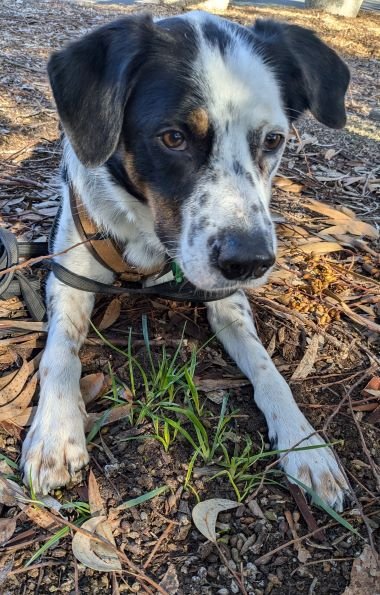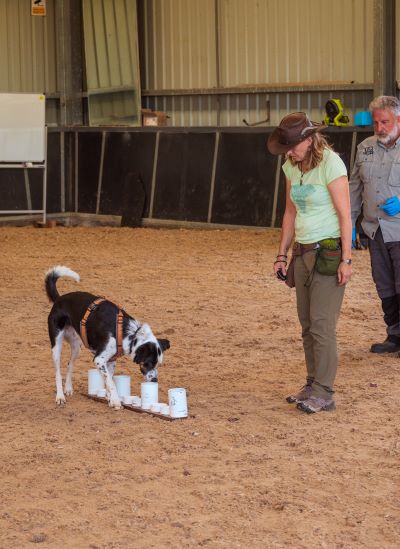“I got Atticus when he was four months old, and he’s an absolute pocket rocket. He’s like 10 border collies in one,” laughs ecologist and conservation dog handler Annett Finger. “He has so much drive that I have to do some kind of work or training with him on every walk we take. If I don’t, he pesters me!”
That intense energy is now being channelled into an unlikely conservation partnership. Together, Annett and Atticus are working with Merri Creek Management Committee (MCMC) to try and detect one of Victoria’s most elusive native plants – the critically endangered Matted Flax-Lily (Dianella amoena) – at Curly Sedge Creek and the surrounding galgi ngarrk grasslands.
 Atticus identifying Dianella. Photograph by Annett Finger.
Atticus identifying Dianella. Photograph by Annett Finger.
The innovative collaboration began when Annett reached out to Friends of Merri Creek (FOMC), looking for a project where she could apply Atticus’s scent detection training. FOMC put Annett in touch with MCMC’s Michael Longmore, who suggested the Matted Flax-Lily – a plant that’s incredibly difficult to find in the wild.
“It’s a very cryptic plant,” Michael explains. “It only flowers for a few months in late spring. The rest of the time, it’s either underground or has fine leaves that get hidden among all the other grasses. You could be standing right on top of one and still not see it.”
Curly Sedge Creek could be the perfect training ground for Atticus and Annett, due to Michael’s sightings of this critically endangered plant along the creek. It’s also the location of an inspiring vision we’re sharing with our community to restore habitat at this hidden place.
Surveys for the plant are usually slow and labour-intensive. “You have to systematically move across large areas, scanning everything. And often, the plants are there, we just don’t know it.”
But if Atticus can learn to sniff them out, things could change dramatically. “Because we’d be relying on smell rather than sight, it means plants hidden under weeds could be found,” says Michael. “And instead of being limited to one or two months of survey time a year, we might be able to search for up to nine months. As long as the plants have leaves, a conservation dog should be able to detect them.”
A gradual process
That’s the theory. In practice, it’s a gradual, careful process that is still in the early stages. Annett and Atticus began training with simpler odours, including a pink dog toy and a koala scat, before shifting focus to the lily.
 Atticus in training with Annett Finger and Paul Bunker. Photograph by Fiona Walsh.“This has been the most complex scent we’ve worked with,” says Annett. “At first, the lilies were in plastic pots, but those pots had their own odour. Atticus was responding to the whole package – lily, soil, plastic – but he couldn’t pick out just the plant.”
Atticus in training with Annett Finger and Paul Bunker. Photograph by Fiona Walsh.“This has been the most complex scent we’ve worked with,” says Annett. “At first, the lilies were in plastic pots, but those pots had their own odour. Atticus was responding to the whole package – lily, soil, plastic – but he couldn’t pick out just the plant.”
To overcome this, Annett turned to a more advanced technique: imprinting Atticus on buried odours, which she learned from dog handler and trainer, Paul Bunker from Chiron K9. She’s now replacing the soil around her lily plants with soil from grasslands and creating compressed ‘pucks’ from mashed-up root and soil.
“It’s a delicate process,” she says. “The scent will change if the roots start to decay or if there’s contamination, even from my own scent, so I have to be really mindful at every stage.”
To ensure the scent stays fresh, Annett plans to make new pucks regularly, storing them in the fridge for up to a week before the scent profile begins to shift. She’ll gradually increase the challenge by having Atticus search for pucks indoors at first, then outside in local parks where she’ll bury them. “I’ll make it harder as we go by burying the puck deeper and deeper,” she explains. “Eventually, we’ll start searching out lilies in areas Atticus doesn’t know, to really test if he can detect them outside.”
When the bright orange harness goes on – the cue that it’s time for real work – Atticus lights up. “That’s his signal. He knows we’re in business,” says Annett. “All the training I do is reward-based, and he’s food-motivated, but his favourite is a squeaky, chewy ball. Even so, he’ll drop the ball if you ask him 'do you want to search again?' And the real buzz for him is when he finds something I didn’t expect and I’m genuinely surprised – that’s his jackpot.”
While it’s likely to be several weeks before Annett takes Atticus to galgi ngarrk for trials, she’s feeling optimistic. “I can’t be absolutely certain yet that it’s going to work, but I’m hopeful. And when Atticus gives me that ‘gotcha face’ – that look he gets when he’s found the scent, I know he’s on the right track.”
As this new partnership takes shape, it’s offering a glimpse into the future of conservation work along Merri Creek: one led not just by keen eyes and dedicated hands, but by a sharp nose and boundless energy.





 Merri Creek Management Committee. 2 Lee St, East Brunswick, Victoria, Australia 3057
Merri Creek Management Committee. 2 Lee St, East Brunswick, Victoria, Australia 3057